This is as close to perfection as museum exhibitions come: 28 oil paintings by Johannes Vermeer (1632-1675) – three-quarters of those known to exist – at the Rijksmuseum in Amsterdam until June 4th. The largest Vermeer exhibition in history took eight years to organise and is unlikely to be repeated.
The “impossible dream” became possible when the Frick Collection in Manhattan, which normally does not lend its three Vermeers, closed for renovation, says Taco Dibbits, director of the Rijksmuseum.
The Rijks and Mauritshuis together own seven Vermeers. Museums in Berlin, Dresden, Dublin, Edinburgh, Frankfurt, London, New York, Paris, Tokyo and Washington DC, and a private collector, US billionaire Thomas Kaplan, loaned the rest.
An unprecedented 200,000 tickets sold before the show even opened. All 450,000 tickets have been sold at this writing, though late-night openings may enable more people to see it. Failing that, the actor Stephen Fry has recorded an enjoyable, free viewing on the Rijksmuseum’s website.
READ MORE
One cannot help hoping there is an afterlife so that Vermeer, who died penniless in a time of war and economic collapse, may savour his posthumous triumph.
The only previous monographic Vermeer exhibition was held in Washington DC and The Hague in 1995-1996, with 22 paintings. Arthur K. Wheelock, one of the world’s leading Vermeer experts and curator of that show, recalls people queuing for 12 hours in snow to see it. A 2017 exhibition entitled Vermeer and the Masters of Genre Painting, at national galleries in Dublin and Washington and the Louvre, was hugely successful, though with half as many Vermeers.
The Rijksmuseum paid tribute to Rembrandt, the other great of Dutch Golden Age painting, with blockbuster exhibitions in 2015 and 2019. They owed Vermeer equal treatment.
We know virtually everything about Rembrandt’s life, precious little about Vermeer’s. Rembrandt painted nearly 80 self-portraits. We’re not sure what Vermeer looked like, though the grinning young man in shadow to the left of The Procuress (1656) may be a self-portrait. He wears a black beret and has shoulder-length, curly, reddish hair.
Several masterpieces eluded the Rijksmuseum. The Kunsthistorisches Museum in Vienna said The Art of Painting (1666-68), considered to be Vermeer’s most important work, was too fragile to lend. Vermeer kept the painting with him until he died.
The Astronomer (1668) is another aching absence, because the Louvre sent it to its partner museum in Abu Dhabi for 20 months. Stãdel Museum in Frankfurt came through with The Astronomer’s counterpart, The Geographer (1669). He leans over a map, compass in hand, staring into space, perhaps dreaming of unexplored tropics.
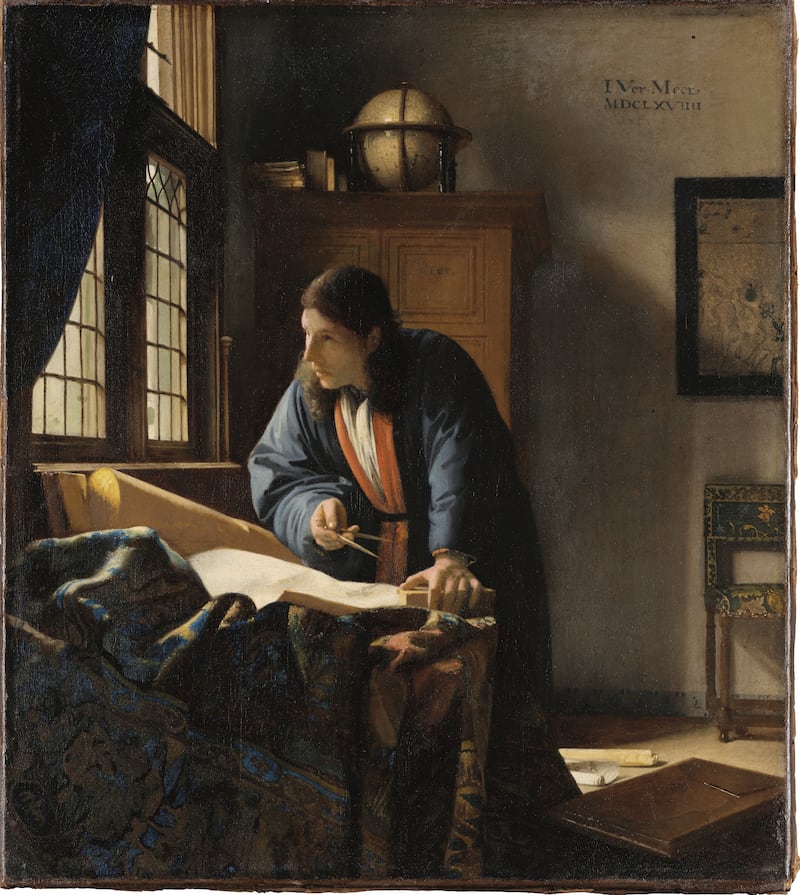
These are the only Vermeers in which men are central figures. Anton van Leeuwenhoek, who discovered micro-organisms, may have been the model for both paintings. Van Leeuwenhoek was, like Vermeer, born in Delft in 1632 and buried in the Old Church. Local authorities asked him to administer Vermeer’s widow’s bankruptcy.
Was the Girl with the Pearl Earring (1664-67) a figment of Vermeer’s imagination? Stand in front of her in Amsterdam, or travel to The Hague when she returns early to the Mauritshuis in April. Contemplate her creamy complexion, parted lips and longing, liquid eyes. She looks back at you. She is alive.
Pearl Earring sold for two guilders – about €1 – in 1881 and was bequeathed to the Mauritshuis in 1903.
The painting inspired Tracy Chevalier’s 1999 novel, which sold five million copies and was made into a film with Scarlett Johansson and Colin Firth. Chevalier’s imagination fanned the Vermeer mania that started when the 19th-century critic Théophile Thoré rediscovered the long-forgotten painter and dubbed him the Sphinx of Delft.
[ Forget the romance: Vermeer was a modern artistOpens in new window ]
The Milkmaid (1658-59) too is part of the world’s visual lexicon. A kitchen maid, dressed in a yellow bodice and lapis blue apron, Vermeer’s favourite colours, pours milk from a jug. Vermeer’s trademark pointillé dapples the bread crusts and ordinary objects with pearls of light. Like figures in other paintings, she concentrates intensely but appears somehow elsewhere. Action in Vermeer’s paintings is minimal, often suspended.
Vermeer records every detail of the kitchen: damp plaster on the window wall; the nail and its shadow above the milkmaid’s head; a foot warmer; Delft tiles comprising the floor skirting.
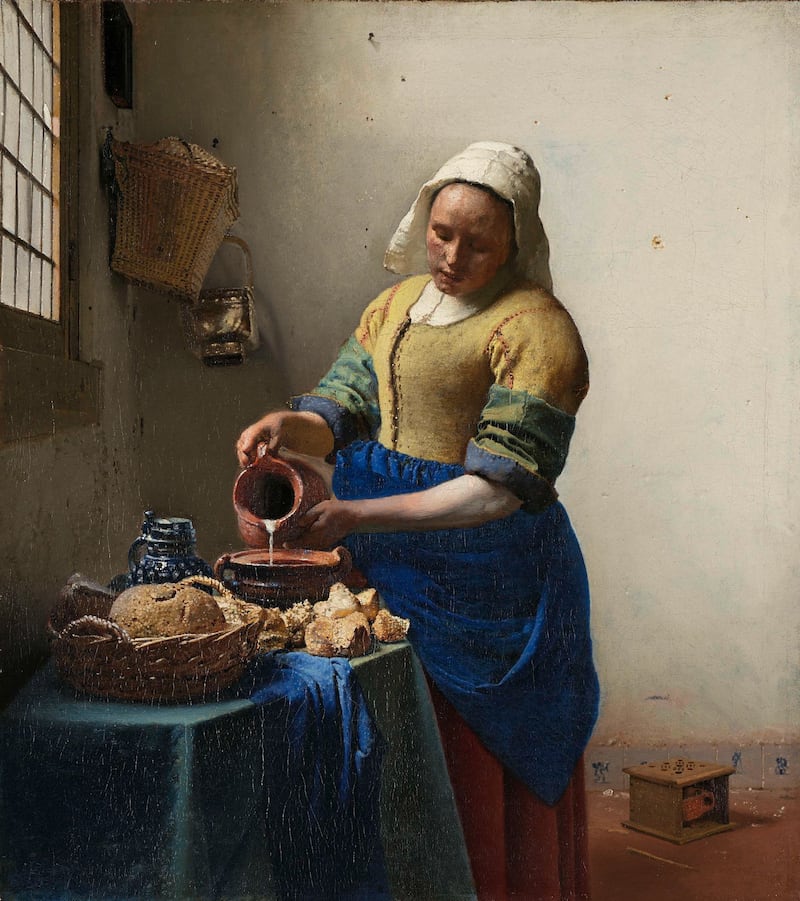
Advanced scanning technologies have revealed that Vermeer painted out a shelf with jugs and a large basket on the floor. He did no preparatory sketches, but painted directly on to the canvas, altering his composition as he went along, usually simplifying.
“It was important for him to isolate the figure of the milkmaid against the white wall. The effect is to make her more monumental, a sort of sculpture,” says Gregor J.M. Weber, co-curator of the exhibition. “Less is more was one of Vermeer’s mottos.”
Vermeer joined the painters’ guild in Delft in 1653, the year he married. He spent four years trying his hand at mythological and religious themes. Girl Reading a Letter at an Open Window (1657-58), on loan from Dresden, is the first painting that is immediately recognisable as a Vermeer.
A delicate woman whose blonde hair is arranged in a chignon with falling tendrils stands before an open window, her face reflected in the leaded panes. She clutches a letter in both hands and reads as if her life depended on it. A beautifully rendered Persian carpet and still life of fruit in a Chinese bowl appear on the table in the foreground. Infra-red studies found a cupid on the wall behind her, which had been painted over after Vermeer’s death. The theatre masque at cupid’s feet could be a premonition of duplicity. With Vermeer, there is always a story, but we are never certain what it is.
Officer and Laughing Girl (1657-58), from the Frick Collection, shows a seated man in a red coat and beaver hat conversing with a young woman wearing a gold and black bodice and white kerchief. The fresh-faced girl smiles engagingly, which is almost unique in Vermeer’s oeuvre. The map behind her appears in other paintings and could signify an absent loved one or the tremendous wealth of Holland as a trading nation.
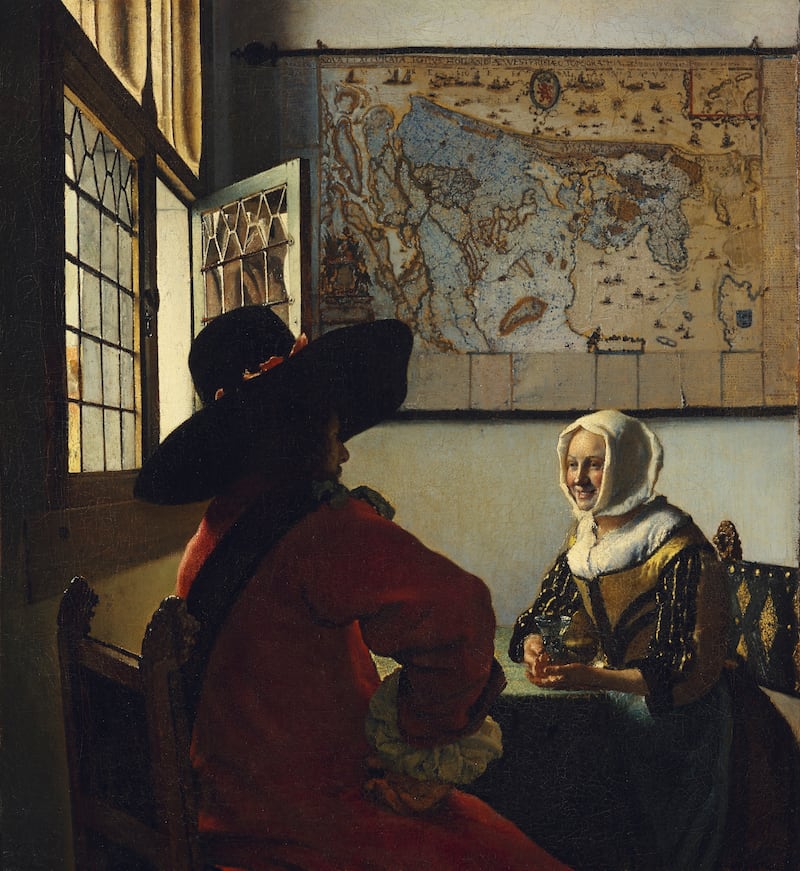
The Rijksmuseum published Weber’s book Johannes Vermeer, Faith, Light and Reflection to coincide with the exhibition. Despite a lack of documentary evidence, Weber has no doubt that Vermeer, who was baptised into the Dutch Reformed Church, converted to Catholicism. “To marry a Catholic woman and live in a Catholic neighbourhood, you had to be Catholic and bring up your children as Catholics,” he says.
Jesuit doctrine influenced Vermeer’s paintings, particularly the bizarre Allegory of the Catholic Faith (1670-74), his last work. Other canvases can be interpreted as morality tales.
The Woman with a Pearl Necklace (1662-64), from Berlin, holds a necklace up to her reflection in a mirror. She wears the yellow, fur-trimmed jacket that belonged to Vermeer’s wife, and which we encounter in several paintings. The exquisitely quiet scene is in fact a typically Jesuit warning against the sin of vanity, says Weber.
The ethereal face of the Woman Holding a Balance (1662-64), from Washington, studies the small scale she dangles from her right hand. Gold and pearls are scattered on the table before her. A painting of The Last Judgment hangs behind her.
“The Last Judgment is a Catholic subject, because Calvinists believed one was predestined,” Weber says. The tiny scales are empty. Is the woman weighing souls? Or merely the light glinting off the metal balance? With Vermeer, God is in the details.
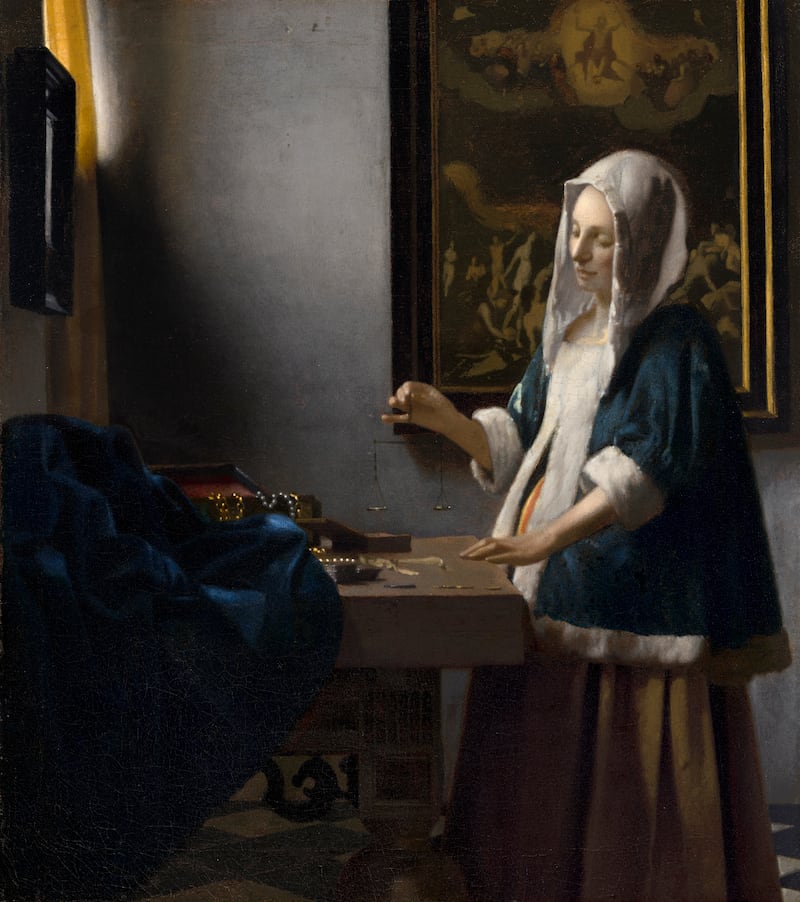
Seventeenth-century Delft was a centre for optical research, which Jesuits embraced as a way of exploring God’s creation. Weber believes Vermeer used optical equipment at the Jesuit station next door to his home in the so-called Papists’ Corner of Delft to perfect his painting technique.
The mainly Protestant Dutch Republic had just fought an 80-year war with Catholic Spain when Vermeer fell in love with Catharina Bolnes, a Catholic. Her family owned brick factories, so while she was more affluent than Vermeer, she also belonged to a persecuted minority. Catholics were not allowed to hold office or organise public gatherings.
Johannes and Catharina’s first wedding banns were crossed out in the register, probably at the instigation of her mother, Maria Thins. The second time, Vermeer dispatched two friends, a painter and a ship’s captain, to Thins’ house to plead with her. She refused to give formal permission, but signed a document saying she would “not prevent or hinder” the marriage. It is on display in the Vermeer’s Delft exhibition at Museum Prinsenhof in Delft.
The couple lived with Thins for 15 years. It cannot have been easy. Catharina bore 15 children, of whom 11 survived infancy. Vermeer was under great pressure to support them and is believed to have retreated from the noise and stress into his studio sanctuary.
“He loved his children, of course, but he also needed to live in the idealised world of his paintings,” Weber speculates. That idealised world was an illusion. “He depicted the very rich. The marble floors and other things were invented ... Vermeer wanted to match the status of his new family, to be a member of the upper class.”
The art history professor Frans Grijzenhout identified in 2015 the location where Vermeer painted The Little Street (1658-59). The red brick facade had been fissured by the explosion of the Delft powder magazine in 1654. Known as The Delft Thunderclap, the explosion claimed dozens of lives, including the painter Carel Fabritius.
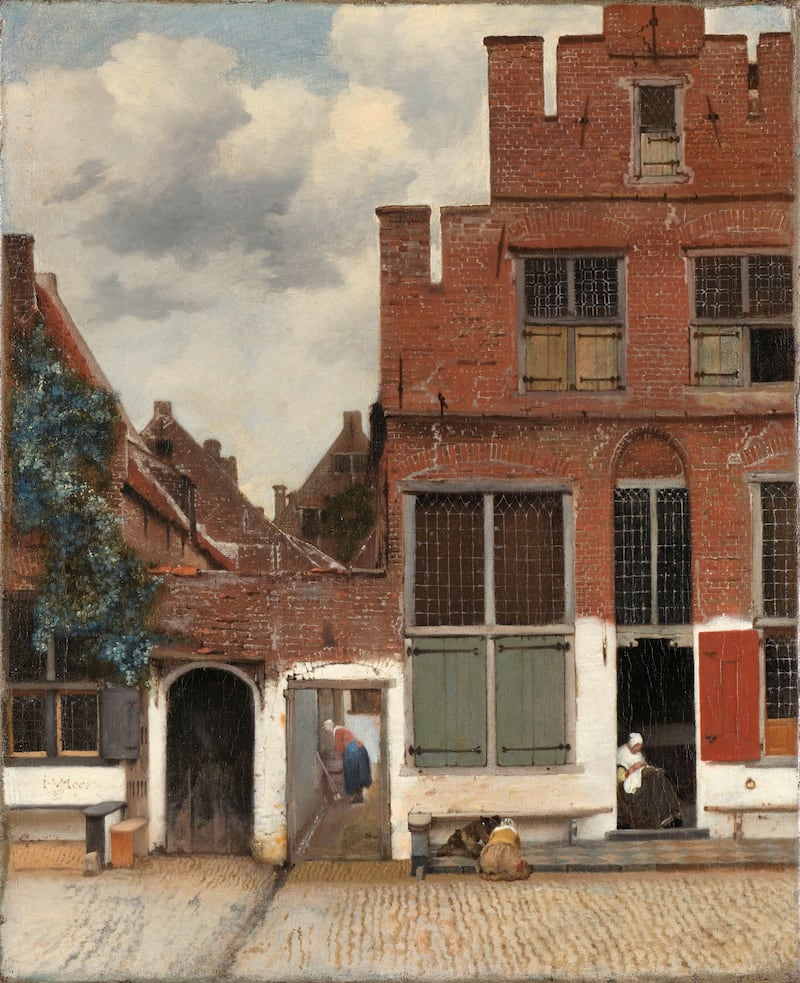
Vermeer’s aunt sold tripe from a stand in the market to support her family, and lived in the house portrayed in The Little Street. Could she be the woman sewing in the open doorway? Or the figure cleaning in the alley? The only children in Vermeer’s oeuvre play on the stoop. The aunt’s house was rebuilt in the 19th century, but the alley is unchanged.
If one stands at the confluence of the canals and Schie river where Vermeer painted his View of Delft (1660-61), the skyline is recognisable, marked by the towers of the New Church and Old Church, where Vermeer was baptised and buried.
Marcel Proust called the View of Delft the most beautiful painting in the world. At an exhibition in Paris, his character Bergotte, a writer, goes into ecstasy over a little yellow wall – in fact a rooftop – bathed in sunlight and concludes: “That is how I ought to have written”. Bergotte collapses and dies in the museum.
Nothing, or very little, happens in Vermeer’s paintings. Yet hundreds of thousands of people will flock to the Rijksmuseum by June 4th, retreating from our over-stimulated age, searching for the otherworldly peace and tranquillity imparted by Vermeer’s paintings.
There is something similar about the oeuvres of Vermeer and Proust; the slow pace at which they were created, the minutiae and perfectionism, the desire to freeze time. “If a thing happens once,” the late poet Derek Mahon wrote, “It happens once forever”.
[ Marcel Proust and Ireland: In search of connectionsOpens in new window ]
Stunning celebration of 17th-century Dutch painting
The Hermitage Museum in St Petersburg and the Hermitage in Amsterdam organised 30 exhibitions together between the fall of the Soviet Union and the Russian invasion of Ukraine. In exchange for contributing to the renovation of the St Petersburg museum, the Amsterdam exhibition centre shared its name and was given access to St Petersburg’s treasures.
The relationship ended abruptly. “The war started on February 24th, and we cut ties on the 4th of March,” says Annabelle Birnie, director of the Hermitage Amsterdam. “We were very strict about not wanting anything to do with the Russian state.”
During the Covid pandemic, Birnie jokes, she had a collection but no public. When Russia invaded Ukraine, she had a public but no collection.
Arthur K. Wheelock was for 45 years the curator of Dutch painting at the National Gallery in Washington, and is today senior adviser to US billionaire Thomas Kaplan, owner of The Leiden Collection. Wheelock received a call from the Hermitage asking if Kaplan would loan his paintings.
Kaplan began collecting 17th-century Dutch paintings with his wife Daphne 20 years ago. They have purchased more than 250 Dutch masters, including 17 Rembrandts, the largest number in private hands. The Kaplans have posted the entire collection online and lend the masterpieces to museums around the world in the interest of cultural understanding.
Kaplan and Wheelock proposed showing history paintings from The Leiden Collection at the Hermitage Amsterdam. The show, entitled Rembrandt and his Contemporaries, is the first designed specifically for the Hermitage Amsterdam since it broke ties with Russia.
Rembrandt and other 17th-century Dutch painters took from the Flemish theoretician Karel van Mander the idea that history painting – allegorical scenes and subjects from the Bible, antiquity or Greek and Roman mythology – was the most noble, prestigious form of art.
“Van Mander believed that history painting was at the highest echelon of art because it required knowledge of the Bible and mythology, and it required imagination to tell these stories through gestures and expressions,” Wheelock explains.
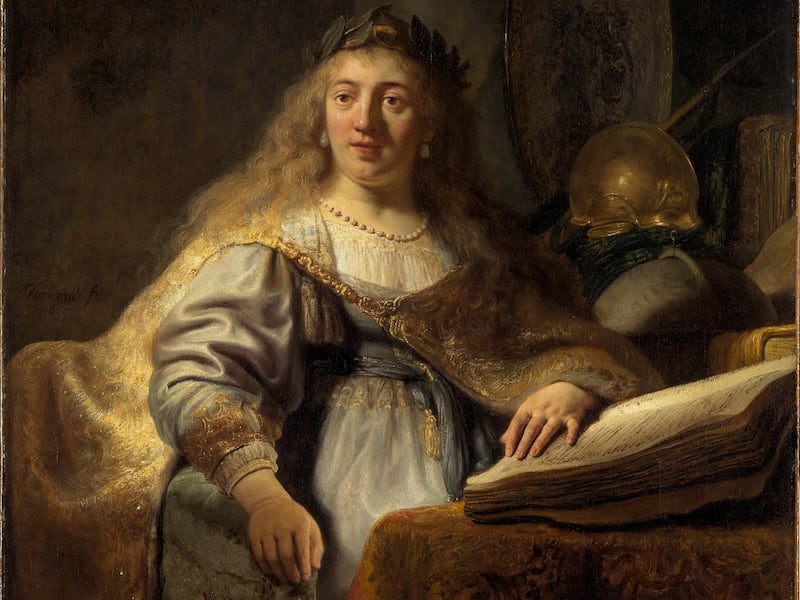
Rembrandt’s Minerva in Her Study (1635) is the signature painting for the exhibition. Rembrandt’s beloved wife Saskia served as model for the goddess of wisdom and war. Dressed in pale blue and gold, crowned with laurel leaves, Minerva rests her forearm on a book – knowledge – and shuns war by turning her back on a shield emblazoned with the head of Medusa, a helmet and spear.
Kaplan has also loaned Rembrandt’s Bust of a Bearded Old Man (1633). The painting resembles the tronies – Dutch for faces – which Rembrandt often painted as sketches for larger history paintings. But the fact that he signed and dated the tiny portrait – his smallest painting ever – shows he considered it a work of art in its own right.
[ How Thomas Kaplan is using art as a weapon of war (2017)Opens in new window ]
Rembrandt painted elderly men and women throughout his life. The large, squarish head with unruly hair and a white beard is charged with emotional energy. The US banker, industrialist and art collector Andrew Mellon, a previous owner, had a velvet-lined leather case built for the painting, which accompanied him everywhere.
History paintings by Ferdinand Bol, France van Mieris, Caspar Netscher, Godefridus Schalcken and Jan Steen, all better known for genre scenes and portraits, are included in the exhibition. Two paintings show figures being comforted by angels, with great poignancy.
Hagar and the Angel (1645) is one of only 13 surviving paintings by Carel Fabritius, Rembrandt’s most talented pupil. Christ on the Mount of Olives (1715) was painted by Arent de Gelder, the student who remained faithful to Rembrandt’s style after late 17th century painters turned to French-style classicism.
[ Rembrandt: the first great ‘selfie’ artistOpens in new window ]
Rembrandt and his Contemporaries runs until August 27th and coincides with the reopening of Rembrandt’s house on March 18th. Combined with the fabulous Vermeer exhibition at the Rijksmuseum until June 4th, these events constitute a stunning celebration of 17th-century Dutch painting.
But could there have been a Dutch Golden Age without the enslavement of more than half a million Africans? Contemporary Dutch society has virtually banned the term Golden Age from its vocabulary, though one is still allowed to refer to the Golden Age of Dutch painting. The word slave is now seen as the equivalent of the N-word, and has been replaced by enslaved person.
The Rijksmuseum, the Netherlands’ most important cultural institution, contributed to the debate by organising an exhibition on slavery in 2021. Last December, prime minister Mark Rutte declared that slavery had been a crime against humanity. King Willem-Alexander may apologise next July 1st, on the 150th anniversary of abolition.
“I am troubled when the beauty of the art somehow gets compromised by the other story,” says Wheelock. “These are miraculous paintings. The other side of the equation of slavery is there. We have to deal with it, but it shouldn’t take away from the beauty of the art that was created.”


















